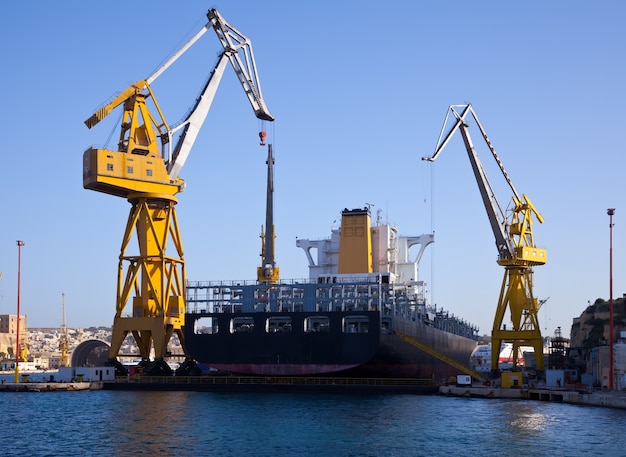Shipbuilding Industry – Overview

Shipbuilding is the construction of large seagoing vessels, usually out of steel. But other materials such as wood and composites can also be utilized. On the other hand, boatbuilding is the construction of smaller vessels (usually up to 50 meters in length) using many similar components. Both ship and boat construction entails the production of relevant marine equipment such as sails, engines, electronics, and other fittings. Shipbreaking is the inverse of shipbuilding, and it occurs when a ship is demolished.
The Far East is currently dominating the global shipbuilding sector; with Chinese and South Korean shipbuilding rapidly exceeding that of the West. The UK shipbuilding sector consists of a small number of specialist shipyards that build ships for the Royal Navy. As well as smaller shipyards that manufacture smaller craft such as tugs, ferries, and coast guard vessels; in addition to fishing and survey/research vessels. Many companies provide the best service for this work like our company, EAN.
Shipbuilding Industry – Definition
The shipbuilding industry is responsible for the construction of ships and other floating boats, which is usually done in a shipyard. Shipbuilding has thousands of years of history and can be observed all around the world. Whether commercial or military, Shipbuilding and repair are classified as “naval engineering,”; with ship repairs being a necessary activity that must be carried out under the supervision of a classification organization. This maintenance can be carried out at sea or in port, but substantial repairs can only be carried out at ship repair yards or dry docks.
Most ships have been made of welded steel since roughly 1940, while some of the earlier ships had catastrophic failures. Constance Tipper of Cambridge University famously examined the problem. And discovered that the fractures that caused the ships to break apart were caused by low-temperature embrittlement of the steel itself; not by the welds. As a result of this discovery, specialized steels that are resistant to thermal embrittlement; such as ABS Steels, are now utilized in ship construction.
Prefabricated pieces of the hull or superstructure are commonly used in modern shipbuilding, with sections of the hull or superstructure being manufactured elsewhere and then assembled at the shipyard. Block building may also include the installation of equipment such as pipes, wires, and other smaller components within each block to reduce the amount of labor required once the individual blocks have been united. Lofts used to undertake ship design, or ‘naval architecture,’ by taking design details from drawings and translating them into templates, cutting sketches, and other data. Computer-aided design (CAD) is used in today’s ship designs and lofting operations (CAD).
What is Shipbuilding Industry used for?
Large ships for both mercantile and military nautical requirements are built-in shipyards. This involves the construction of container and freight ships, as well as passenger and naval ships. Shipwrights, also known as shipbuilders, have been a part of human history for thousands of years, with evidence of ship hulls reaching back to 3100 BC in Ancient Egypt and Egyptian pottery dating back to 4000 BC. Modern shipbuilding is normally done in a shipyard and can be completed on-site by putting pre-assembled vessel pieces together.
What Type of Industry is Shipbuilding?
Shipbuilding is a capital-intensive and cyclical industry, with fleet expansion having drastic consequences for a shipping line. Cruise lines (carrying people) and freight lines are the two types of shipping lines (carrying cargo). Tankers make up the largest category in terms of tonnage among the various types of ships. The industry manufactured roughly 15,000 tankers in 2019, with a total gross tonnage of 13 million. In comparison, just 773,000 tonnes of cruise ships were built during the same time period.
Many other industries, such as marine engineering, offshore industries, and defense, have linkages to the shipbuilding industry. Shipbuilding is the manufacture of large, primarily ocean-going vessels for commercial or military purposes. For the maintenance, conversion, and eventual decommissioning of the boats, the industry is backed by product and service providers. The China State Shipbuilding Corporation, China Shipbuilding Industry Corporation, Daewoo Shipbuilding, and Marine Engineering, Hyundai Heavy Industries, Samsung Heavy Industries, and Imabari Shipbuilding are among today’s major shipbuilding companies, which are major global suppliers of bulk carrier vessels, large container ships, tankers, and Ro-ro ships.
Famous Countries for Shipbuilding
Over the years, various countries have been known for their shipbuilding. But modern industrial shipbuilding has struggled in countries with high labor costs and where government subsidies have been abolished. Although shipbuilding has declined in Europe over the last 50 years, it remains a vibrant center for commercial shipbuilding, with over 150 large shipyards employing around 120,000 people in the EU. In terms of tonnage, Europe maintains a 6% market share, with the industry staying vital in several nations, contributing to regional industrial infrastructures as well as national defense and security concerns. The construction of complicated boats such as cruise ships, ferries, luxury yachts, and naval vessels is the main focus of shipbuilding in Europe.
The Jones Act was enacted in the United States, limiting the kind of ships that can transport domestic cargo. Although contract prices remain high, especially when compared to the competition in Japan, China, and South Korea, this has provided some protection for commercial shipbuilding in the United States. China, Japan, and South Korea were the top three shipbuilding nations in 2019, with China finishing 22.3 million gross tonnes of ships. These countries continue to produce the majority of the world’s ships today.
Indonesia’s Shipbuilding Industry
Indonesia, which is along some of the world’s busiest maritime lanes, has enormous sea transportation potential. In Indonesia, there are around 250 shipyards with an annual production capacity of 1 million DWT for new shipbuilding and 12 million DWT for ship repair. While the downturn in investment and consumption in 2013 had an impact on maritime cargo, the industry is expected to rebound once the general economy improves, boosted by strong freight demand in the ASEAN region. Unlike their considerably larger counterparts in China, Japan, and South Korea, most Indonesian yards are not prepared to manufacture warships beyond 20,000 deadweight tons.
In the long run, Indonesia’s expanding manufacturing industries; and greater production and processing of mineral resources will ensure rising export demand. While imports will benefit from strong consumer spending. The building of new port facilities will gradually relieve congestion at key terminals. This has been one of the industry’s biggest bottlenecks. Although the regulatory environment dictates those local interests will continue to dominate shipbuilding, partnerships have previously proven to be effective win-win situations. There are also opportunities in the passenger vessel space for companies that can supply at a competitive price; have experience with the aforementioned vessel types.
The 2008 Shipping Law of Indonesia
Intending to increase competition and attracting more private investment; the 2008 Shipping Law simplifies requirements on business license and port administration. The law also abolishes Pelindo, the state-owned port operator, from its monopoly in port services. Or more precisely, Pelindo I, II, III, and IV, each of which operates in different regions. However, the industry’s competitiveness is still lacking. Especially with importing and exporting corporations complaining about traffic and bad service at Indonesian ports. Indonesia has dropped two places in the World Bank’s global competitiveness report; in terms of cross-border cargo trade, slipping behind other ASEAN countries.




Leave a Reply